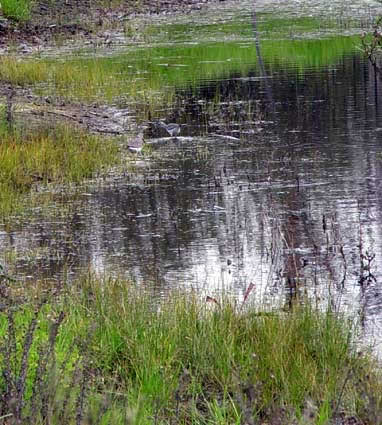What are those things, I asked myself?

In the small pool at my feet, a half dozen inch-long creatures were swimming with an odd, rather wavy motion, unlike anything I had seen before. These weren't fish. Despite the fin-like and sinuous wriggling of the upper body, the tail was pointed and finless. Nor were these tadpoles. Not with upper bodies flailing about like this. Gills? Salamander? I didn't think so. Not here on the coastal plain under this glorious late-January sky.
Frankly, I was puzzled. One thing was sure, though. These critters were tied to water.
The rains, this year, have been quite extraordinary: both early and abundant. Everywhere the vegetation was showing signs of an early spring. On the upland portions of the marsh around me, the lupines were leafing out thickly. Bladderpod was beginning to flower. And there was more water here than I had ever seen before. Vernal pools everywhere. One or two covered several acres, but the one I was looking into was tiny. A few feet on a side. Not much more than a scrape in the ground. Shallow, with clear water. And these things.
I stepped into the mud around the pool to get close enough to see clearly. My eyes aren't what they used to be--nor are my binoculars the sort for close-up work. So, muddy shoes it was. And fairy shrimp!
Of course, I had read of these animals before, but it had not occurred to me that I could see them here. Yet, there was no doubt. They were swimming on their backs, with their many pairs of legs weaving back and forth to create the waviness that had seemed so strange. They appeared translucent, and though a reddish tinge pervaded them, the only definite points of color lay in the black dots of their tiny eyes.
Fairy shrimp filter detritus or scrape algae from objects in their pools to get food, as do many other aquatic creatures. What sets them apart is their amazing adaptations to the ephemeral habitats they live in--vernal pools; some species even adapted to places that may not see rain for years on end.
The eggs laid by fairy shrimp are hardy. Depending on the species, eggs may survive years before hatching. Eggs may be blown on the wind. Even passed through digestive systems. Yet some species brood the eggs, and it is the larvae that must survive harsh conditions, becoming encysted so that they can speed to maturity when the rains come again.
It is the specialization of fairy shrimp that makes them so vulnerable to human activities. As we fill in vernal pools and wetlands for our own housing and commerce, their necessary habitats disappear. Thus it is up to us to see to it that we make provision for these creatures while we make use of what once was theirs.
Fortunately, the marsh I was observing is one that will remain. Home to the occasional naturalist finding something new and amazing. Home to the fairy shrimp, doing what they have always done.


